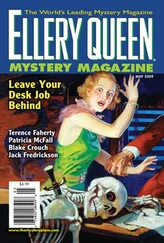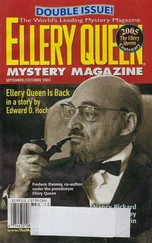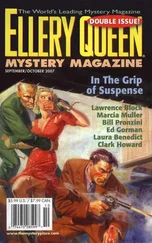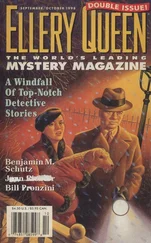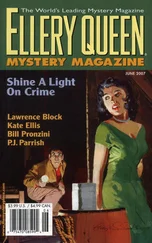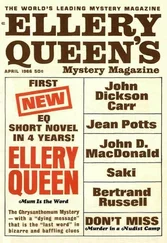Рон Гуларт - Ellery Queen’s Mystery Magazine. Vol. 127, No. 5. Whole No. 777, May 2006
Здесь есть возможность читать онлайн «Рон Гуларт - Ellery Queen’s Mystery Magazine. Vol. 127, No. 5. Whole No. 777, May 2006» весь текст электронной книги совершенно бесплатно (целиком полную версию без сокращений). В некоторых случаях можно слушать аудио, скачать через торрент в формате fb2 и присутствует краткое содержание. Город: New York, Год выпуска: 2006, ISBN: 2006, Издательство: Dell Magazines, Жанр: Детектив, на английском языке. Описание произведения, (предисловие) а так же отзывы посетителей доступны на портале библиотеки ЛибКат.
- Название:Ellery Queen’s Mystery Magazine. Vol. 127, No. 5. Whole No. 777, May 2006
- Автор:
- Издательство:Dell Magazines
- Жанр:
- Год:2006
- Город:New York
- ISBN:0013-6328
- Рейтинг книги:3 / 5. Голосов: 1
-
Избранное:Добавить в избранное
- Отзывы:
-
Ваша оценка:
- 60
- 1
- 2
- 3
- 4
- 5
Ellery Queen’s Mystery Magazine. Vol. 127, No. 5. Whole No. 777, May 2006: краткое содержание, описание и аннотация
Предлагаем к чтению аннотацию, описание, краткое содержание или предисловие (зависит от того, что написал сам автор книги «Ellery Queen’s Mystery Magazine. Vol. 127, No. 5. Whole No. 777, May 2006»). Если вы не нашли необходимую информацию о книге — напишите в комментариях, мы постараемся отыскать её.
Ellery Queen’s Mystery Magazine. Vol. 127, No. 5. Whole No. 777, May 2006 — читать онлайн бесплатно полную книгу (весь текст) целиком
Ниже представлен текст книги, разбитый по страницам. Система сохранения места последней прочитанной страницы, позволяет с удобством читать онлайн бесплатно книгу «Ellery Queen’s Mystery Magazine. Vol. 127, No. 5. Whole No. 777, May 2006», без необходимости каждый раз заново искать на чём Вы остановились. Поставьте закладку, и сможете в любой момент перейти на страницу, на которой закончили чтение.
Интервал:
Закладка:
Childers turned pale with alarm and burst out, “But this could mean the end of our beloved monarchy. We have to do something!”
“We will,” Ganelon assured him. “First we will ask the queen to send the Prince of Wales abroad for a bit. Then we must bring this whole Ripper Prince business out into the open.”
Childers shook his head. “I don’t understand.”
Ganelon asked him, “Does this British sense of fair play I’ve heard so much about really exist?” Childers assured him that it did. Ganelon continued, “Then if he is Jack the Ripper or not, doesn’t the Prince of Wales deserve a public trial like any other Englishman?”
Childers knit his brow in incomprehension.
“Here’s our job,” said Ganelon. “We must convince enough people that a great miscarriage of justice has taken place to prompt a parliamentary inquiry.”
“But that could take years,” insisted Childers.
“Not if we use modern technology,” replied Ganelon.
The next day Childers called from the palace and commandeered several public cabinets at Telephone House. The Irregulars were eager to be part of the endeavor. Ganelon coached them about the questions they were to put to the people they called. “First time around you’ll ask if they think we have the Prince of Wales in the Criminal Asylum at Norwich. If they say no, as most probably will, you’ll ask, ‘Are you sure about that?’ and hang up. That’ll give them something to think about. Others may say they don’t know. Then you ask, ‘Well, shouldn’t you find out?’ and hang up. We’ll let them stew in the good old British sense of fair play for a bit. Like Captain Childers here, I’m sure they’ve all heard a rumor or two about the Ripper Prince.
“Then we call them back. This second time around some, if only a few, are going to say, ‘Yes, we do have Prince Albert in the Criminal Asylum at Norwich.’ That’s when you say, ‘Then shouldn’t we let him out?’ That’ll get the groundswell going. And we’ll keep calling until we get solid results.”
The Irregulars broke up into teams and went through the London telephone directory and made trunk calls all around the country. In the course of the first few days they focused these calls considerably. They found it better to call during mealtime when the family was gathered together at table. Also, as the Honorable Chalk (or was it young Cheese?) pointed out, the term the Criminal Asylum at Norwich only confused the people on the other end of the line. Most knew the place better by its initials, the CAN.
By the beginning of the second week, letters to the editor appeared in The Times of London and respectable people were discussing the matter on the street. By the week’s end a motion had been placed before the House of Commons calling for an official inquiry into the rumors that the Prince of Wales had been imprisoned in the Norwich facility without due process.
Within days, a board of inquiry visited Norwich and interviewed those inmates of the ward in question who had been admitted to the facility immediately after the Ripper killings and the supposed secret trial. These they eliminated for a variety of reasons. (One, for example, spoke nothing but Welsh. This combined with the fact that none of the other inmates spoke a word of that language went to the heart of his claim to be the true Prince of Wales.)
The official inquiry made public its report that Albert Edward, the Prince of Wales, had never been confined to the Criminal Asylum at Norwich.
A rumor persisted that an inmate who arrived within the proper time frame had escaped not long afterwards, prompting the story that the queen’s people had abducted the Prince of Wales from the hospital to hide him in plain view as his own double, a story so absurd that even Dragon House could make nothing of it in the penny-dreadful line.
When Queen Victoria’s Bertie returned from his trip abroad as his haughty old self, England breathed a sigh of relief and the tales of his being an impostor were forgotten completely. Ganelon returned home to San Sebastiano with the queen’s warmest thanks.
The detective kept up a correspondence with Captain Childers for the next few years. The man’s regiment was soon called back to South Africa by the outbreak of the Boer War. With the close of hostilities, Childers’s dream of new worlds to conquer took him to New York, where the kind of advertising billboard work he was interested in was already a reality. Then he settled in North Carolina and went to work in the publicity department of a large tobacco company about to introduce a new pipe tobacco in a convenient pocket tin. They brought Childers in to come up with an elegant name for the product, something to appeal to the carriage trade. Ganelon was not surprised when Childers chose to call the pipe tobacco “Prince Albert,” in honor of his father’s friend and Queen Victoria’s beloved consort.
A few months later, the detective passed between the twin cigar-store Indians flanking the door to Chez Rick, the American-style tobacco store on the rue de Rigolo, and entered the spittoon-littered premises. Old Vitelli the physiognomist had recently written from Naples asking Ganelon to send him an American Indian peace pipe for his grandson, who was in love with the Wild West.
As Ganelon stood examining the beribboned pipes in the counter display case the telephone on the wall rang. With a smile to his famous customer the proprietor put the receiver to his ear. “Chez Rick,” he said. “Rick speaking.” Then, after a moment, he hung up the receiver and turned his scowling face to Ganelon. “It’s been like this all month,” he said. “Wiseacre children of American tourists, they call up and ask if I’ve got Prince Albert in the can.” The tobacconist gestured to a shelf of dark red tins decorated with a black-and-white photograph of Prince Albert, Queen Victoria’s consort, a picture the detective remembered having seen before. “When I say, ‘Yes, I have,’ they laugh and say, ‘Then shouldn’t you let him out?’”
Ganelon looked away in embarrassment. Of the many pranks in the necklace of science and invention, this one appeared to be of his own making.
Just then another customer approached the counter. Ganelon recognized him as an American by his celluloid collar and the stylographical pencil in his pocket.
“Do you have Prince Albert in the can?” he asked.
Monsieur Rick gave the man a dark look. Then through clenched teeth he replied, “Yes, we do.”
To Monsieur Rick’s great relief and Ganelon’s, the American said, “Fine. I’ll take one.”
Copyright © 2006 James Powell
The Jury Box
by Jon L. Breen
Dennis Lynds, who died in 2005 at age eighty, was among the best and most prolific practitioners of detective fiction of the past forty years. What may be his last book is notable for the pleasure of the pulp-style narratives but even more for its snapshots of the writing life and the development of a major talent.
*** Dennis Lynds writing as Michael Collins: Slot-Machine Kelly: The Collected Private Eye Cases of the One-Armed Bandit, Crippen & Landru, $29 hardcover, $19 trade paper. The billing is ironic: Though the Collins byline would become more famous, these 13 stories, dating from the 1960s and all but one from Mike Shayne Mystery Magazine, were originally published as by Lynds. The honest and frequently self-critical story notes touch on the abandonment of a Watson narrator, why one of the stories was written too hastily, and Kelly’s gradual evolution into the more serious one-armed shamus of Collins’s novels, Dan Fortune, whose Edgar-winning debut, Act of Fear (1967), was expanded from the last story in the book.
Читать дальшеИнтервал:
Закладка:
Похожие книги на «Ellery Queen’s Mystery Magazine. Vol. 127, No. 5. Whole No. 777, May 2006»
Представляем Вашему вниманию похожие книги на «Ellery Queen’s Mystery Magazine. Vol. 127, No. 5. Whole No. 777, May 2006» списком для выбора. Мы отобрали схожую по названию и смыслу литературу в надежде предоставить читателям больше вариантов отыскать новые, интересные, ещё непрочитанные произведения.
Обсуждение, отзывы о книге «Ellery Queen’s Mystery Magazine. Vol. 127, No. 5. Whole No. 777, May 2006» и просто собственные мнения читателей. Оставьте ваши комментарии, напишите, что Вы думаете о произведении, его смысле или главных героях. Укажите что конкретно понравилось, а что нет, и почему Вы так считаете.

